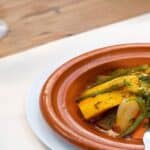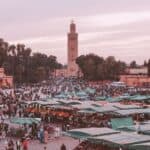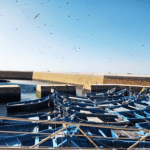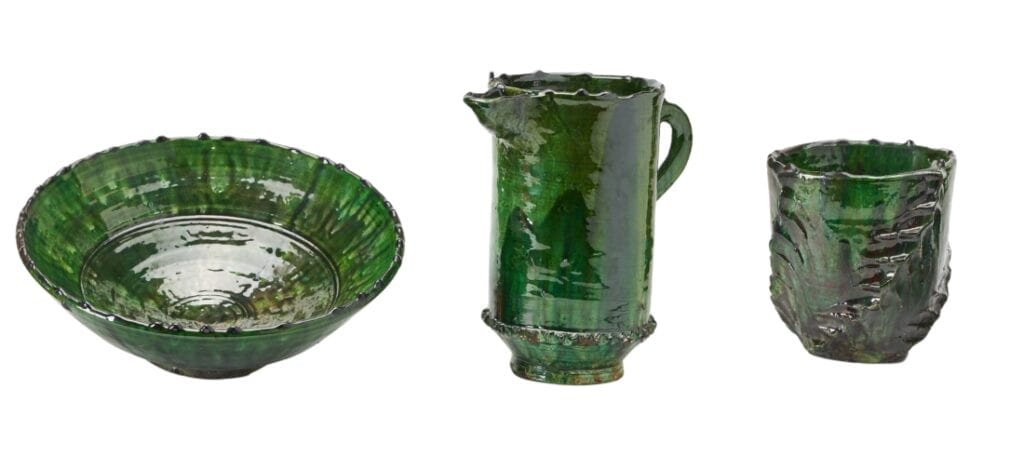
In the village of Tamegroute, the spirit of Moroccan tradition is alive. This place mixes ancient whispers with modern life. Here, the essence of Moroccan pottery thrives, crafted by artisans with deep roots in tradition. Their work weaves through daily life, capturing the hearts of both locals and travelers with its shiny green glaze. Holding Tamegroute pottery is like touching history, all thanks to the traditional artisan skill.
This art is celebrated for both its beauty and durability, telling stories of Moroccan culture. It’s a craft that finds its way into the kitchen, where tagines boil with Morocco’s rich flavors. The secret of the green glaze, hidden within the earth’s minerals, is known only to Tamegroute’s potters. Each detail of their work shares a story, keeping the craft alive through the ages.
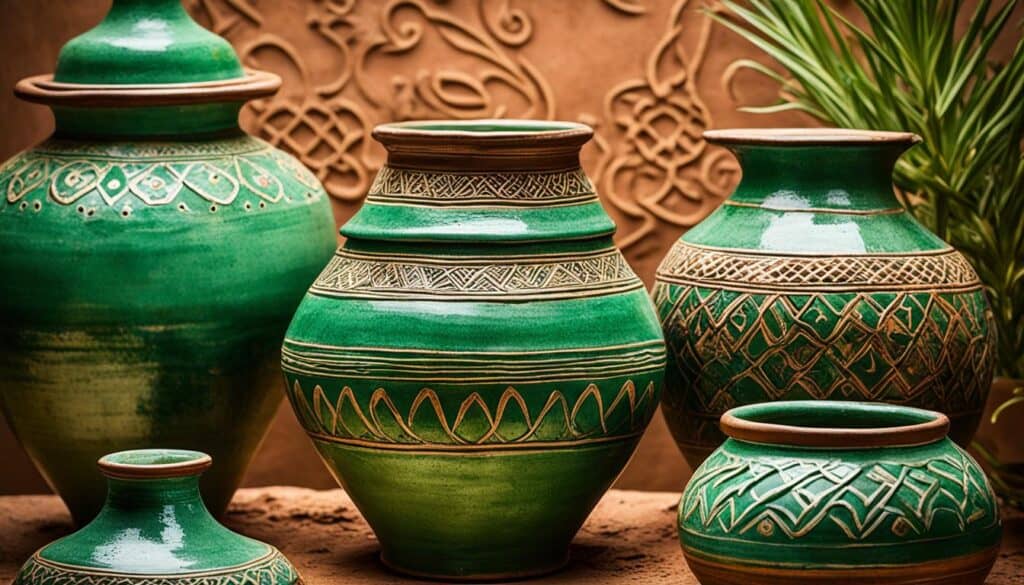
Our exploration into this lasting art unfolds its many secrets. We examine the striking patterns and the charm that fascinates people worldwide. Thus, we see how Tamegroute pottery embodies Moroccan life. It’s a life beautifully portrayed through pottery that continues to bewitch and inspire.
The Artistic Legacy of Tamegroute Pottery
Tamegroute pottery holds a big piece of Morocco’s cultural heritage. This mastery of ancient techniques combines with the beauty of traditional designs. It keeps alive a history that dates back to the 16th century in southern Morocco. Artisans preserve a tradition that shows the essence of Moroccan ceramics and its people’s soul.
Looking into this ancient art, we find the detailed zellige technique. Here, artisans create mosaic patterns with great precision. They use the potter’s wheel and hand-building methods to shape each piece. Then, they add glazes that turn clay into art. Notably, a special glazing process uses a glass-like substance. This gives the pottery its well-known strength and shine when fired in wood-burning kilns.
Preserving Ancient Techniques and Designs
Tamegroute pottery is famous for its colors. The emerald green stands for fertility and growth, giving each piece a sense of life. The shades of blue show protection and spirituality. These designs are vibrant parts of a story influenced by various historical cultures.
Artisans like Fatima Zahra Hassan and Ahmed El Haddad add new ideas to traditional shapes. This keeps Moroccan ceramics appealing worldwide. Cities like Fes, Safi, Meknes, and Marrakech are pottery centers. Fes, for example, has over six centuries of a rich Islamic legacy in its blue and white pottery.
| Technique/Aspect | Description | Cultural Significance |
|---|---|---|
| Wheel Throwing | Rhythmic shaping on potter’s wheel. | Enduring skill, symbol of continuity. |
| Glazing | Applying henna for signature green tone. | Shows innovation within tradition. |
| Firing | Wood-fired kilns for unique finishes. | Connects to Morocco’s earthen roots. |
| Color Symbolism | Blue for protection, Green for growth. | Infuses spirituality and nature. |
| Global Appeal | Modern designs for worldwide interest. | Represents a cultural bridge. |
There’s a deep bond between artisans and their work. It’s not just about making a living. It’s about keeping a legacy alive for future generations. The value of these ceramics is clear in Moroccan festivals, ceremonies, and daily life. Every piece tells a story and adds to Morocco’s rich culture.
As the global market demands more artisanal products, we see the importance of Tamegroute’s cultural depth and beauty. We must support efforts that protect these traditions and help the artisans thrive.
Discovering the Unique Green Glaze of Tamegroute
The unique green glaze of Tamegroute has caught the eye of many around the world. It’s a key feature of Moroccan ceramics found only in Tamegroute. It gets its stunning look from a mix of oxidized copper and magnesium. The age-old glazing methods used here, present since the 11th century, count on the deep know-how of local artisans instead of modern tools.
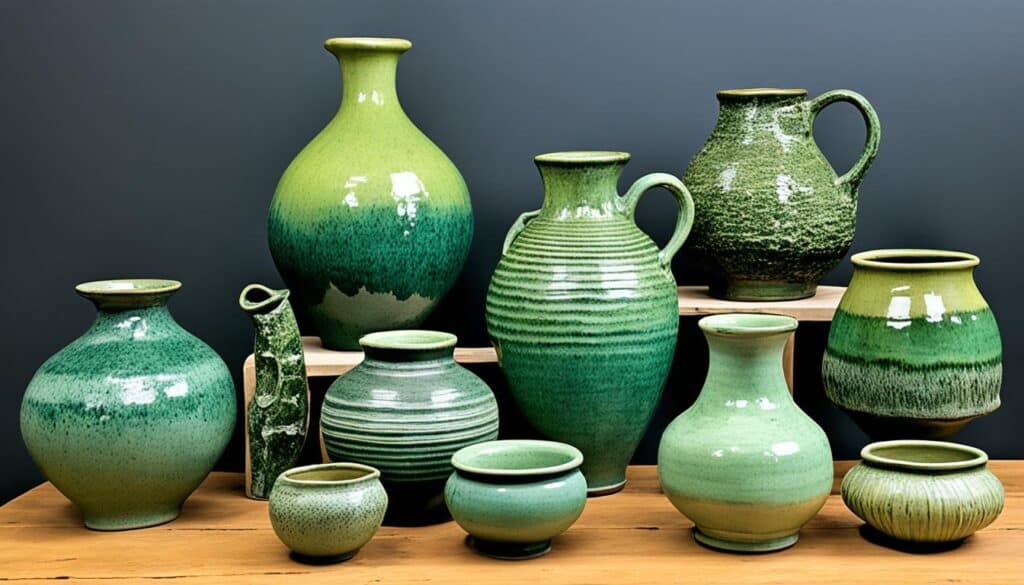
Each piece reflects the shared knowledge of the seven renowned pottery families in Tamegroute. Their studios are filled with the sounds of hard work and devotion to their art. They shape, glaze, and fire their pieces using age-old methods, surrounded by the Draa River’s landscape. This river provides the special clay that’s key to their creations.
| Element | Description | Pottery Feature |
|---|---|---|
| Unique Green Glaze | Blend of 1% oxidized copper and magnesium | Waterproof and vibrant color |
| Clay Source | Draa river-bed clay | Distinctive texture and hardiness |
| Glazing Technique | Ancient methods with no measuring devices | Endless variations in glaze appearance |
| Color Variations | Ochre shades, iron oxide alternatives | Diverse visual presentation |
The pottery of Tamegroute mixes its ancient methods with its visual appeal, making it a symbol of Moroccan ceramics and an art philosophy. The
“green roofs”
in Tamegroute, covered in the same special glaze, show this philosophy for all to see. They shine under the Moroccan sun, adding beauty to the village.
The Tamegroute Ceramics Cooperative is a key part of this enchanting cultural scene. It attracts visitors to Zagora who want to see how the unique green glaze is made. This blend of elements results in waterproof pots and dishes. These choices reflect the local people’s toughness and the lasting impact of their pottery methods.
Exploring Tamegroute: A Village Imbued with Craftsmanship
Tamegroute village lies deep in Morocco, showcasing a deep legacy of craftsmanship. Its history is alive in every alley, sharing stories of traditional skills. The village is known for its unique pottery and natural materials.
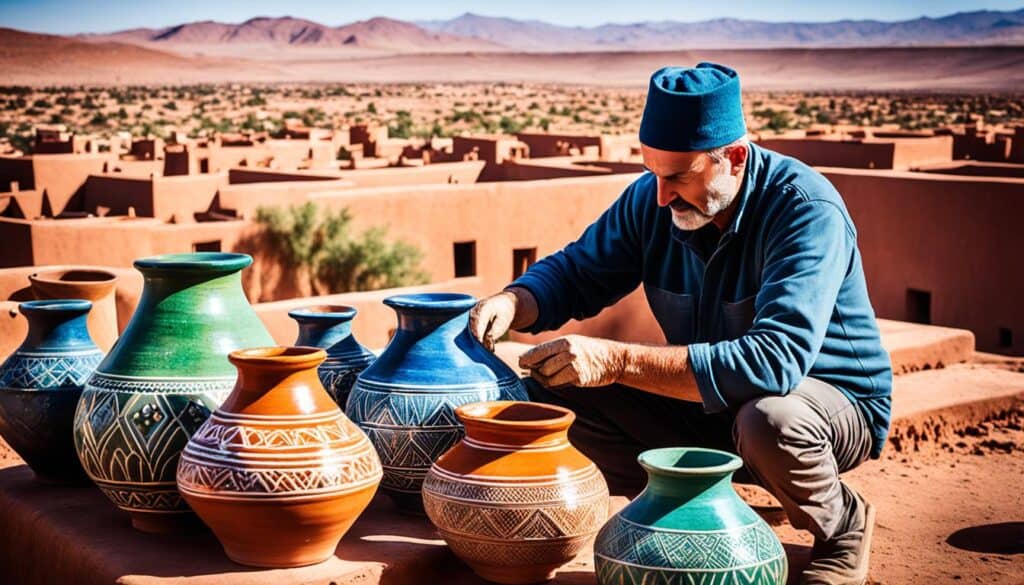
The village is rich in tribal heritage and traditions. Here, Moroccan craftsmanship is more than just a job; it’s a lifestyle. It captures the village’s soul. The workshops and artisans’ movements reflect Tamegroute’s rich culture.
The Traditional Skills Passed Through Generations
Skills in Tamegroute’s pottery come from generations of teaching, not from classrooms. Craftsmen add life to clay with age-old techniques. This craftsmanship is as important to the village as the oases that dot its landscape.
The Natural Materials and Tools Used in Pottery Making
The village artisans use natural materials from the Moroccan land. Local mines supply the clay they work with. They use organic pigments for their ceramics, showing a bond with nature. This sustainable approach highlights traditional pottery tools as extensions of the artisans.
This approach includes pottery wheels, handcrafted brushes, and kilns. All are made from natural materials, completing a cycle as natural as the seasons.
| Material | Source | Use in Pottery |
|---|---|---|
| Clay | Local mines | Forms the base of pottery |
| Organic pigments | Indigenous plants and minerals | Used for creating vibrant glazes |
| Handcrafted tools | Artisans’ workshops | Shaping and detailing pottery |
Visitors to Tamegroute not only see Moroccan crafts but also feel a spiritual journey. The pottery tools here carry wisdom from ancestors. They keep Tamegroute’s artistic fire burning for all to see.
Conclusion
Each region in Morocco adds its own touch to the nation’s pottery, creating pieces filled with stories and history. Styles like Fes blue, Safi’s bold colors, and Tamegroute’s green glaze are not just art. They are a tribute to centuries of culture and tradition. Craftsmen’s use of ancient techniques, such as wheel throwing and open-air firing, shows a deep respect for history.
Moroccan pottery is part of everyday life, bringing beauty and history into homes and communities. As modern production grows, keeping these traditions alive is crucial. It preserves not only the art but also the well-being of the artisans. Protecting Moroccan pottery means protecting the nation’s cultural and economic future.
The world is starting to love Moroccan ceramics for their uniqueness and craftsmanship. This global attention mixes old skills with new designs, creating a fresh demand. Morocco’s ceramic artists use special methods to get a unique glossy finish. This signature look makes Moroccan pottery sought after worldwide.




